Our outstanding experience in Nepal in 3 weeks
Our outstanding experience in Nepal in 3 weeks
–
Traveling to Nepal was on my mind for so long, I never imagined how it actually feels like to be in this country. I just knew about the documentaries of the biggest mountains in the world and the earthquake years ago. I can now say after our 3 weeks in Nepal, this country absolutely blew my mind and touched my heart. It is still one of my favorite countries in the world due to the beauty of the mountain scenery and the incredible people with their view of life. I can’t recommend enough to come to Nepal and choose one of the many hiking trails for all different levels. You can complete most of the hiking trails in 2 weeks, but since there is a lot to see in Kathmandu as well, we recommend 3 weeks in total.
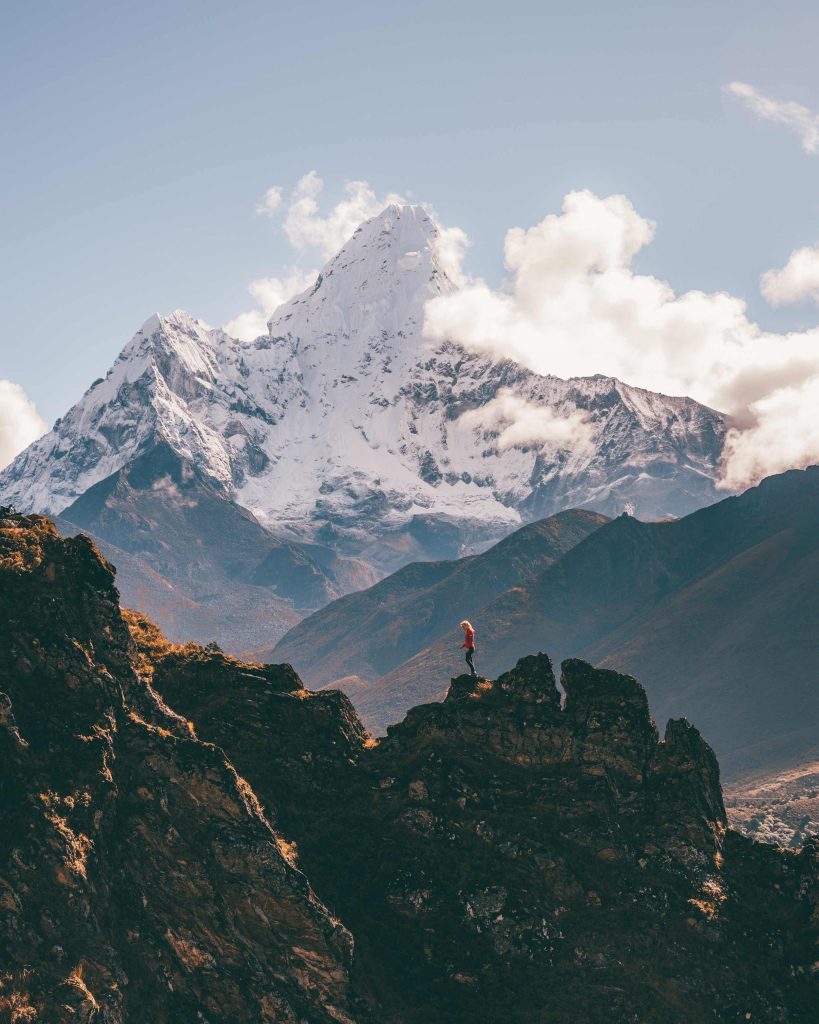
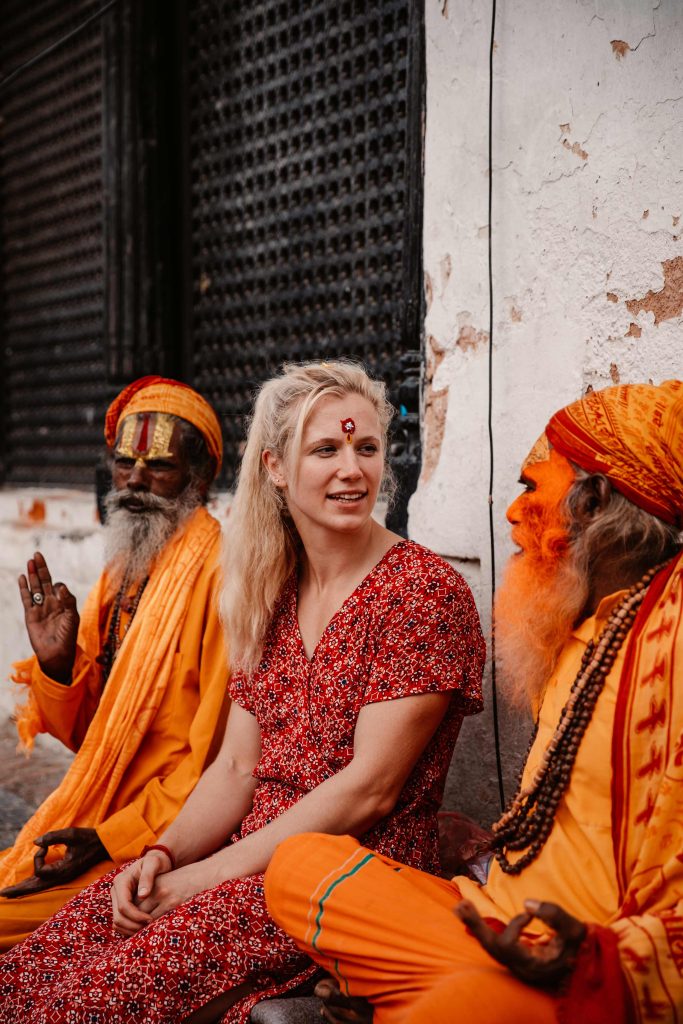
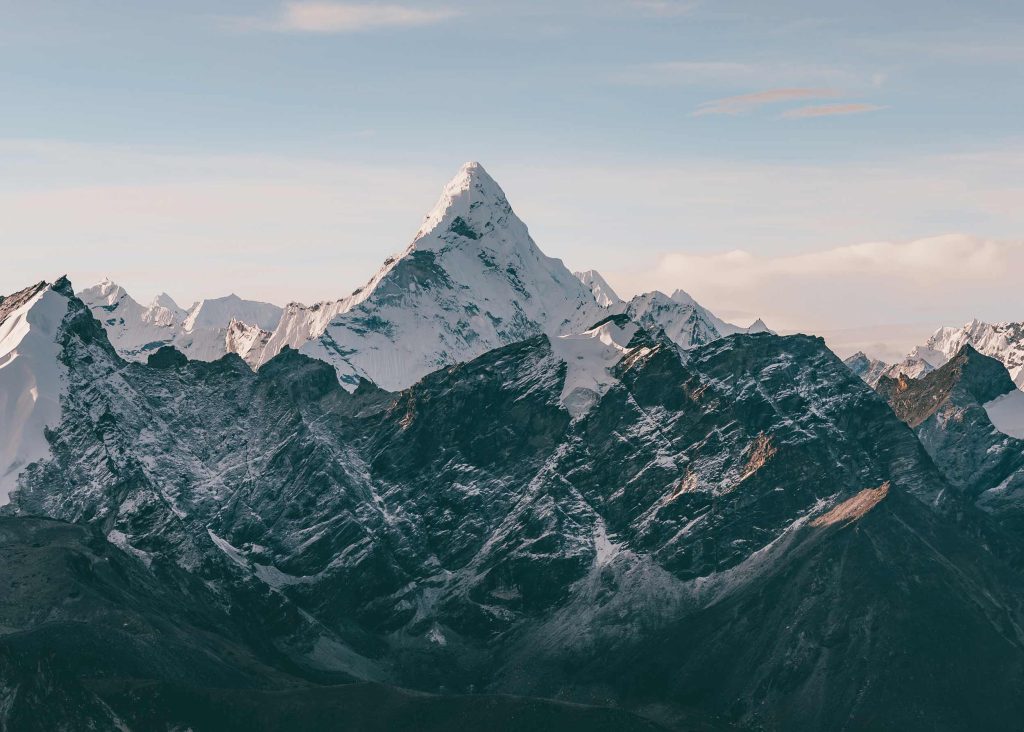
____________
Take a flight to Kathmandu ✓
____________

1. Explore the capital city Kathmandu, Day 1-3
There is so much to see in Kathmandu, so many incredible temples and squares. Also the street life in Kathmandu is really nice! Definitely plan some time to stroll through the streets and soak in the vibes. The city is located 1296m above sea level, 1.4 million people live here. My favorite temple was Shri Pashupatinath Temple, similar to India, women bath themselves and their clothes in the water of the river and a few meters downstream the temple and river is used for cremation. When it gets dark they hold a beautiful ceremony with fire. We also recommend to visit the 3 different squares: Kathmandu Durbar Square, Bhaktapur Durbar Square and Patan Durbar Square. They are all really beautiful. Definitely plan 2-3 days in Kathmandu! If you still have to buy all the outdoor gear for a hiking trip, Kathmandu has hundreds of cheap stores for imitated outdoor gear, plan even more time.
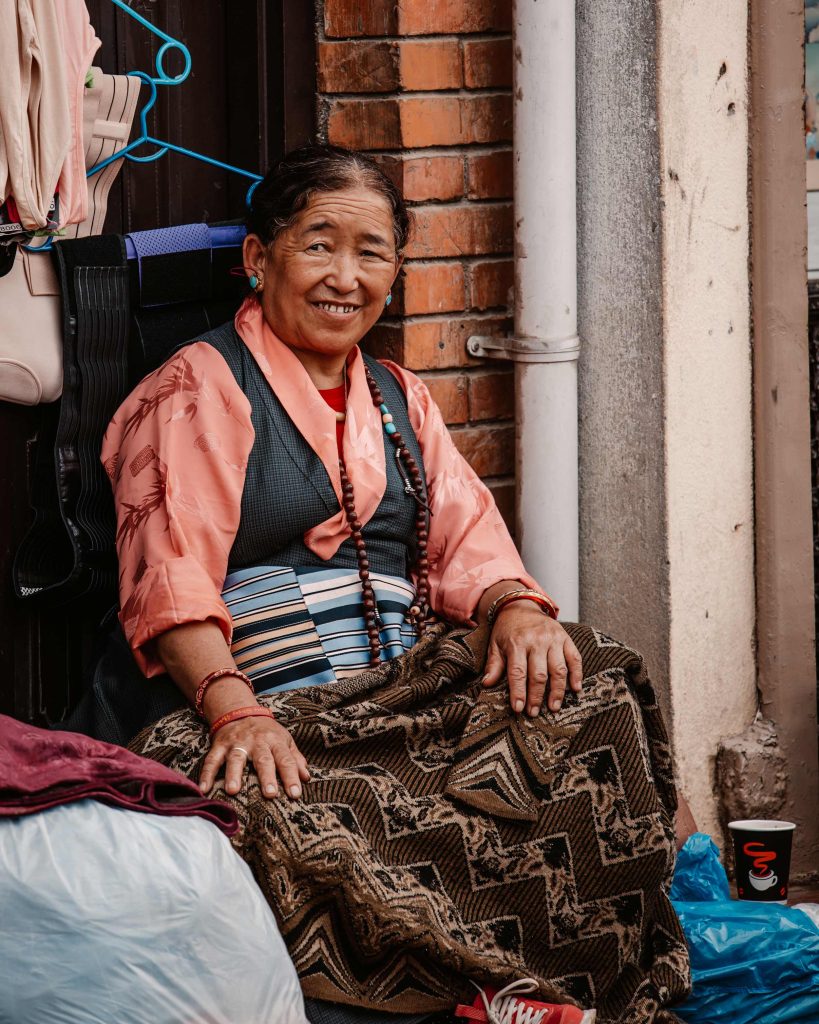
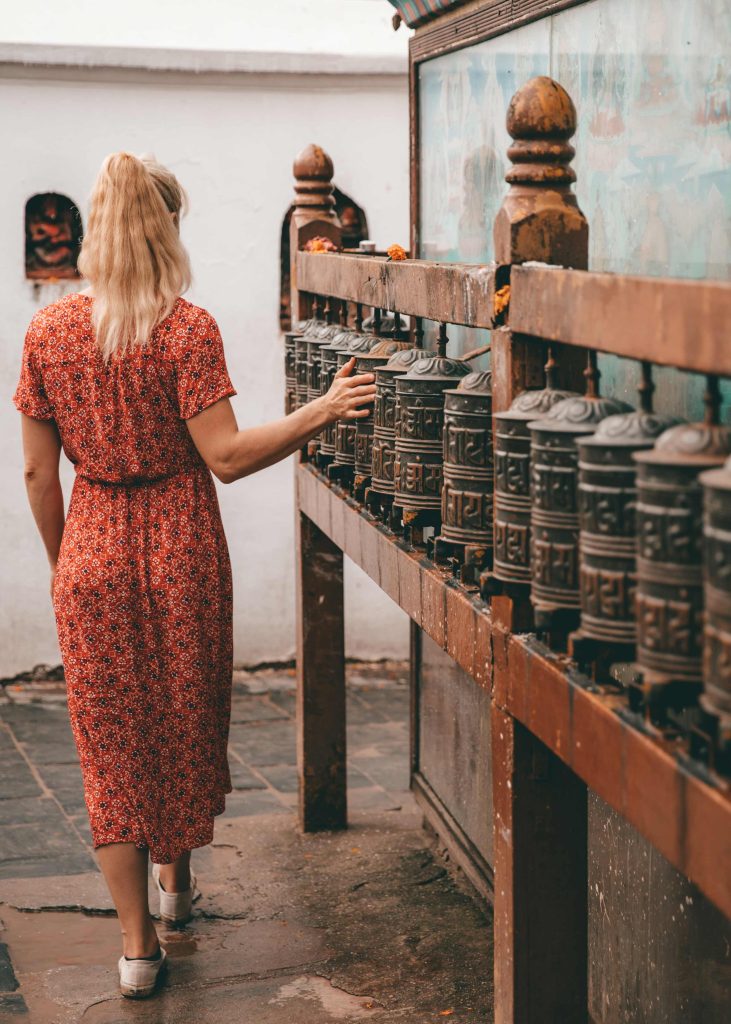



What to do?
- Boudhanath Stupa
- Shri Pashupatinath Temple
- Kathmandu Durbar Square
- Bhaktapur Dubar Square
- Patan Durbar Square
- Swayambhunath Stupa
- Explore Thamel
- Seto Machendranath
- Asan Market
- Shree Ghah Chaity Temple
- Garden of Dreams
Where to eat?
- Bhavana Café
- Nourish by Avata
- Organic Smoothie Bowl Café
- Pumpernickel Café
- Roadhouse Restaurant
- Thulo Thakali
- Himalaya Café
- OR2K
- Yangling!!!
Where to stay?
- directly in Thamel: we highly recommend Nepal Pavilion Inn (cheap, clean and very friendly family, lots of art, the owner even invited us for a family dinner)
↠ Read more: Our 15 favorite must-see places in Kathmandu, Nepal
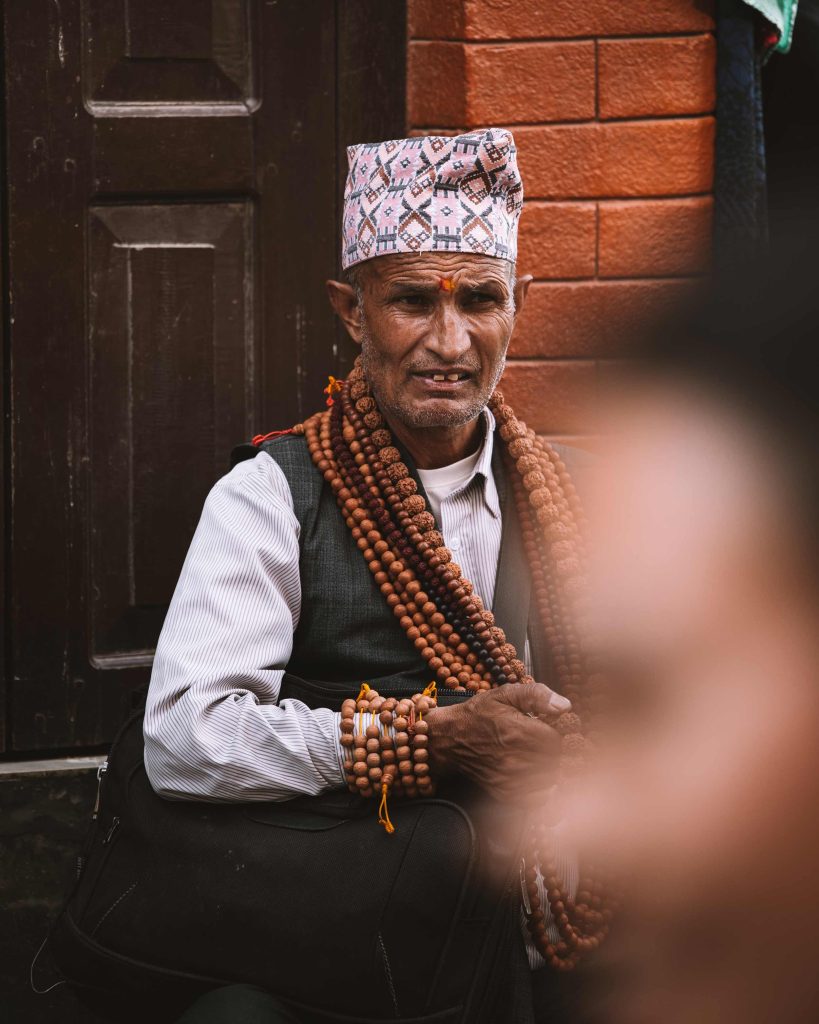

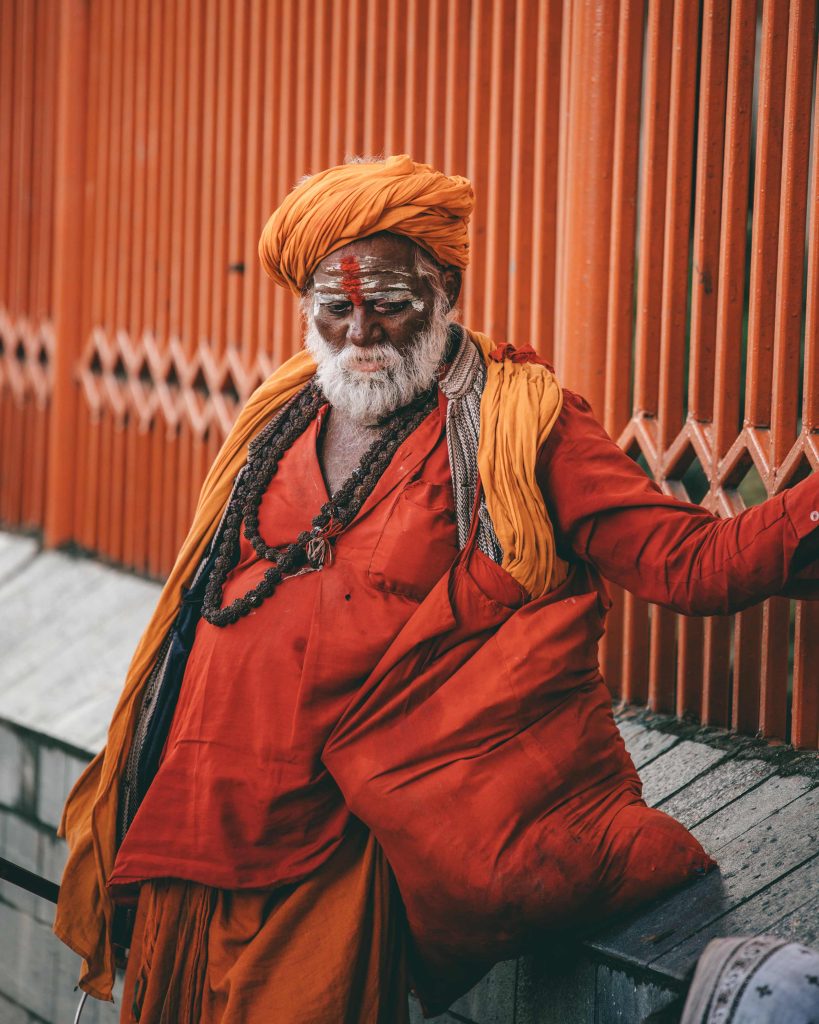


2. Support local projects around Kathmandu
We found a few incredible projects supporting women in Nepal. By joining activities of these organizations, you get eye-opening education and you give back to an important humanitarian cause.
Sasane Sisterhood of Survivors Cooking Class
On our last day in Kathmandu we escaped the rain by participating at a very special cooking class with Indira and Sasane-Sisterhood orginisation. It was wonderful! We learned how to make the traditional dumplings called momos, dhal bhat and chai tea. The Sisterhood of Survivors organisation helps victims of human trafficking by giving these women a home and access to further education and so much more. Check out their website! Please, if you are in Nepal, book a cooking class or a trekking tour with them.
Panauti Community Homestay
This homestay is a secret tip to experience authentic Nepali lifestyle. 32km, around 2 hours South East of Kathmandu, there is this Newari village. Most buildings are brick buildings surrounded by beautiful rice terraces and Himalayan mountains. You will learn how to cook traditional food, harvesting, traditional dancing and clothes, or you join a hiking and village tour. A family of the Panauti homestay can earn a good amount of money, 80% of this money goes to the women in charge, 20% into a community fund improving the buildings and education.
Seven Women Cooking Class
Join a cooking class at the Seven Women social enterprise. They help marginalized Nepalese women by teaching them new skills and literacy. By joining a cooking class you support the organization a lot and you learn about Nepali cooking and their background.

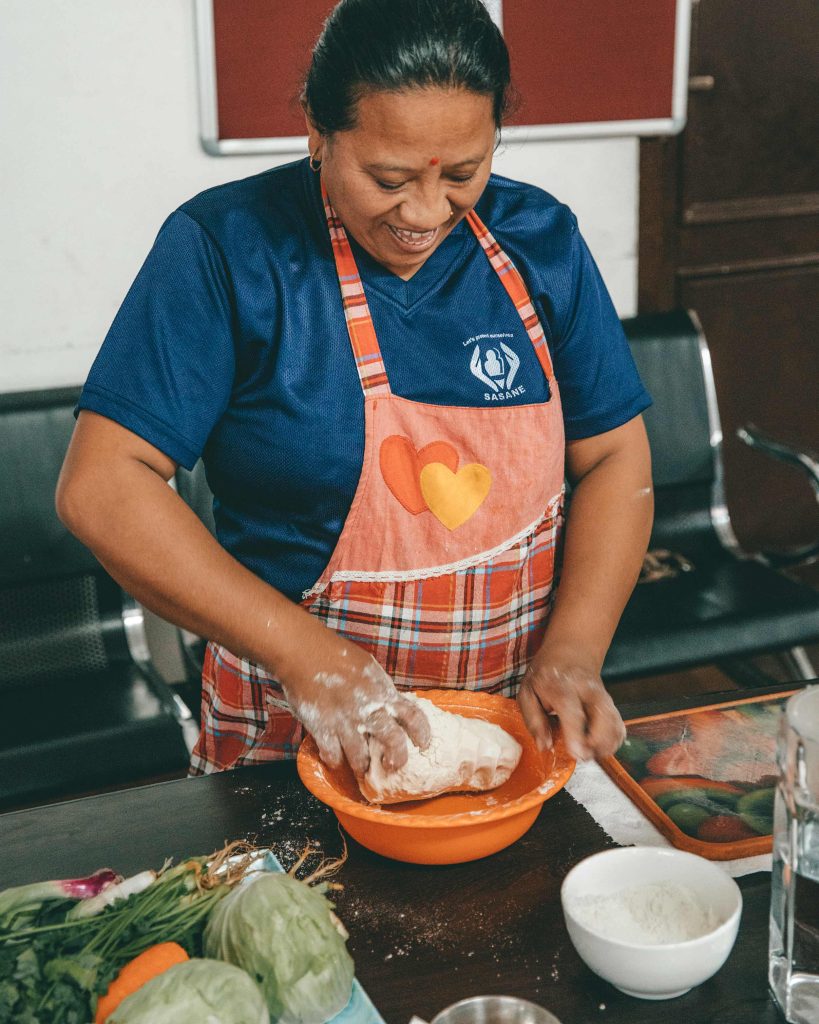
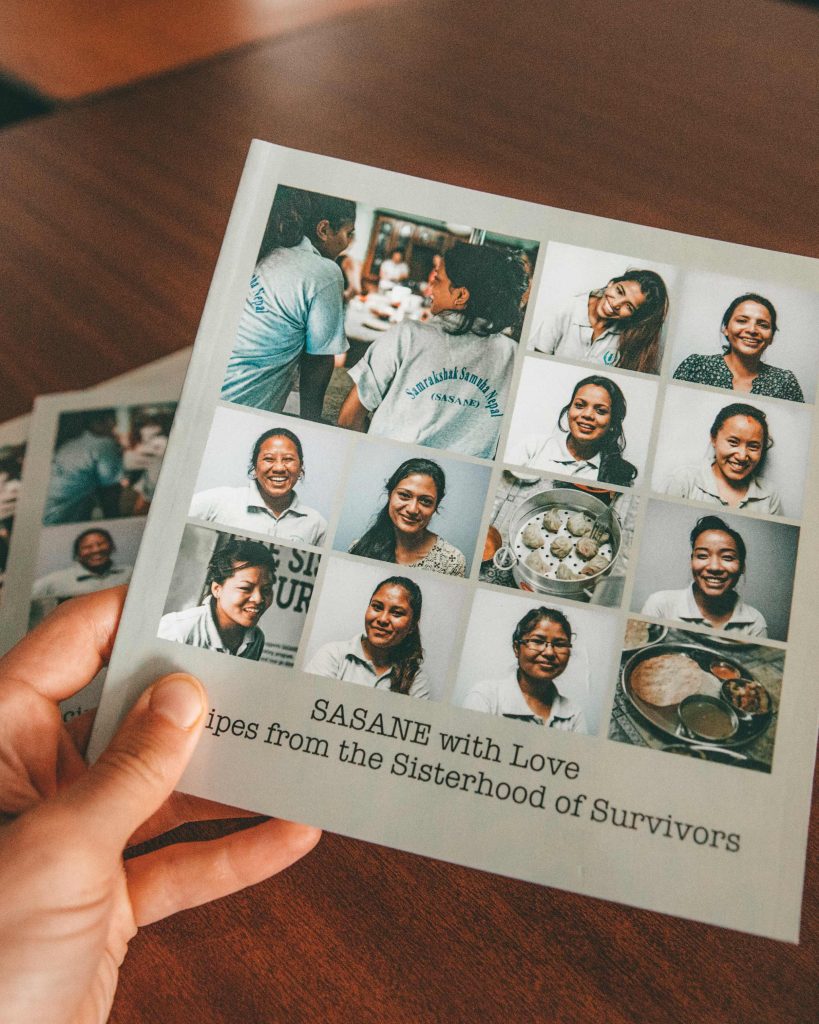
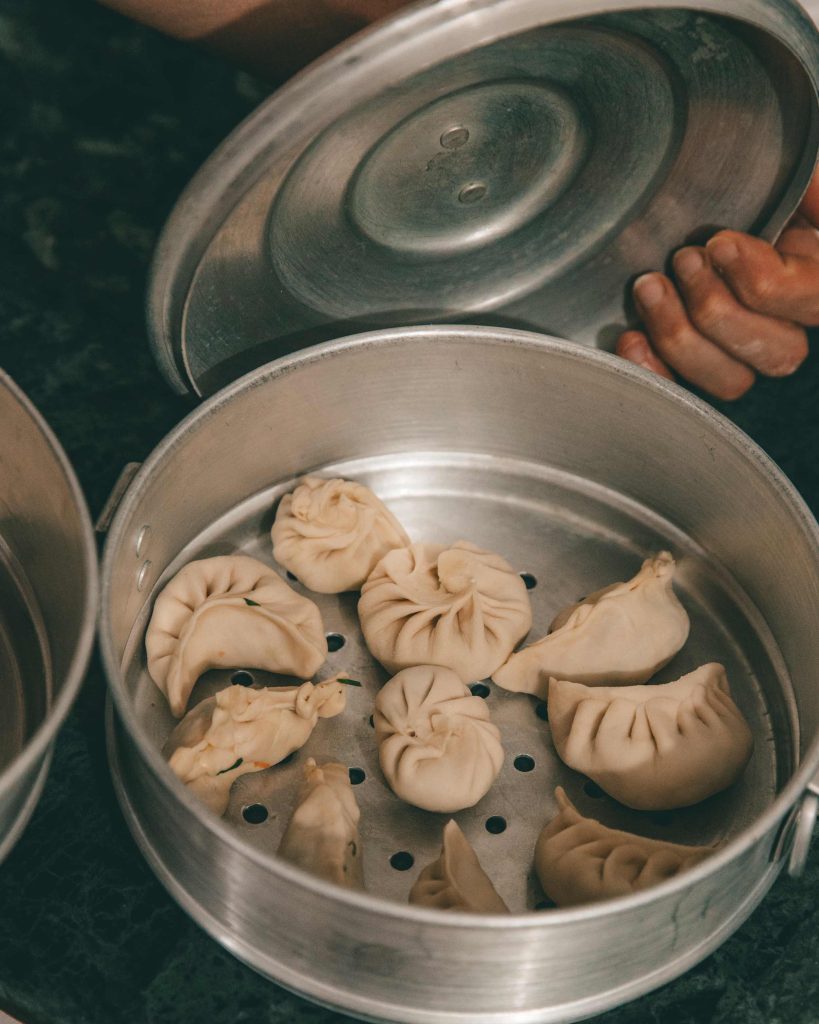

____________
Take an inland flight from Kathmandu to Lukla ✓
____________
3. Hike the 3-passes trek together with Everest Base Camp & the beautiful Goyko Lakes, Day 3-18
When we planned to go to Nepal, we knew we want to go hiking for most of the time. But you have to choose between different hiking trails, located on different altitudes. We chose the hardest hike with 3 peaks more than 5.000m, since we knew we can handle high altitude from our previous climbs in Peru. Compared to the treks around Pokhara you will hike directly in the white snowy mountains with views on Mount Everest and you can easily add Mount Everest Base Camp to your itinerary. You will probably start with short trousers in Lukla, hiking through forests and walking over beautiful suspension bridges. With hiking meters of meters up the mountains, it gets colder and you need long hiking trousers, fleece and jackets. For us the highlight of the hike was definitely Kala Patthar for sunrise in front of Mount Everest, our Island Peak summit and the beautiful Goyko lakes.
What to do?
These are the different hiking stages:
- 1. Lukla to Monju
- 2. Monju to Namsche Bazaar
- 3. Namsche Bazaar to Phortse
- 4. Phortse to Dingboche
- 5. Dingboche day hike (for acclimatization): Ngarkat Summit
- 6. Dingboche – Chukung Ri – Chukung
- 7. Chukung – Kongma La Pass (PASS 1) – Labuche
- 8. Labuche – Gorak Shep – Everest Base Camp
- 9. GorakShep – Kala Patthar – Dzonghla (*instead of Dzonghla go to Dingboche)
- (*Dingboche – Chukung – Climbing Training)
- (*Island Peak Climb)
- (*Dingboche to Dzonglha)
- 10. Dzonghla over Cho La Pass (PASS 2) to Goyko
- 11. Goyko day hike: 5th lake hike
- 12. Goyko Ri mountain hike and Goyko to Dhole –> or Goyko, Renjo La (PASS 3), Lunden
- 13. Dhole to Lukla –> or Lunden, Thame, Namsche Bazaar + another day to Lukla
You can do this 3 passes hike together with Everest Base Camp in 14 days, maybe adding 1 or 2 more break days. The tours marked with a “*”, were added by us, since we climbed Island Peak after getting enough acclimatization.
Where to eat?
- You will get incredible food in the teahouses. Almost every teahouse serves really good dumplings and dhal bat. We were absolutely surprised by the quality of food in the mountains!
Where to stay?
- There are teahouses every 30 minutes to 2 hours. Even if you have to stop your daily hike you will find a close teahouse for little money for the night. Most teahouses have a dining room with an oven in the center and private rooms with a double or two separated beds. The toilet and shower is on the floor most times.
↠ Read more: coming soon


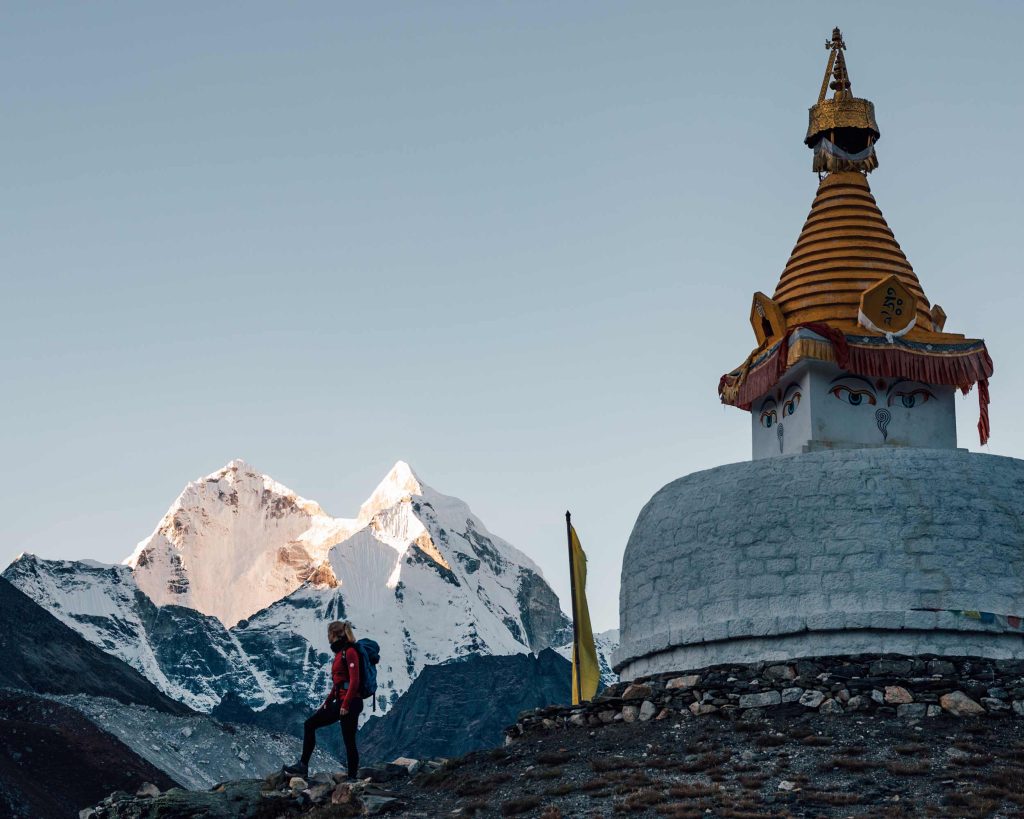
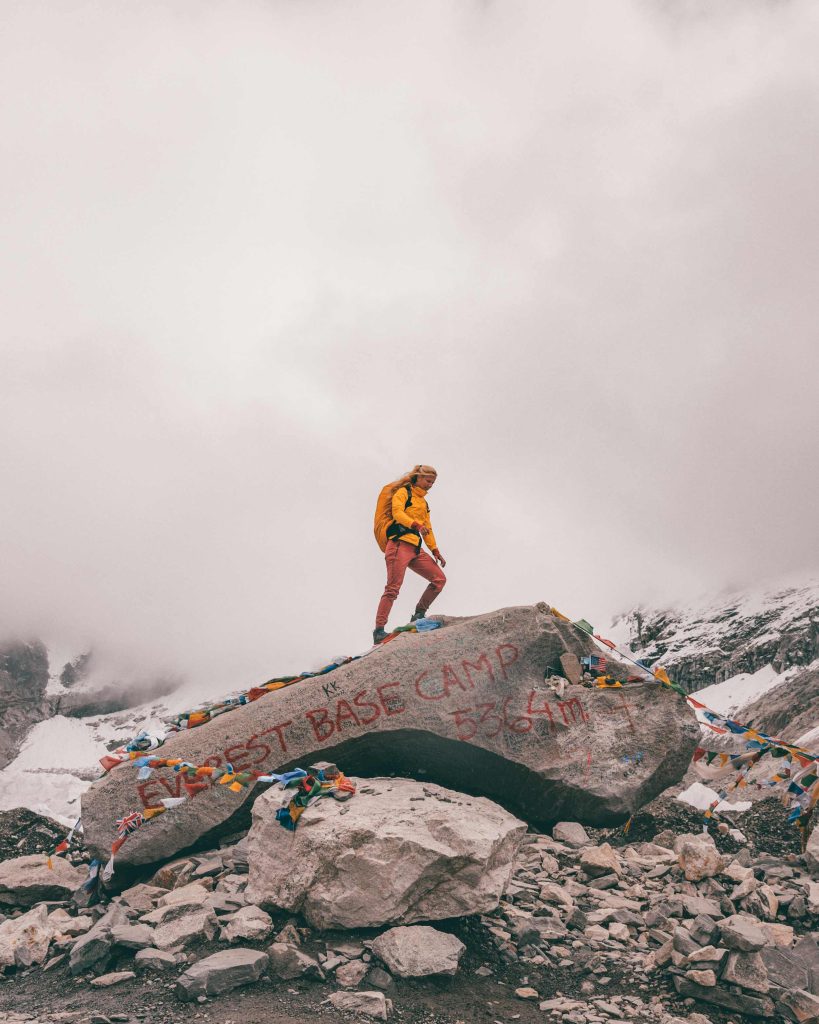
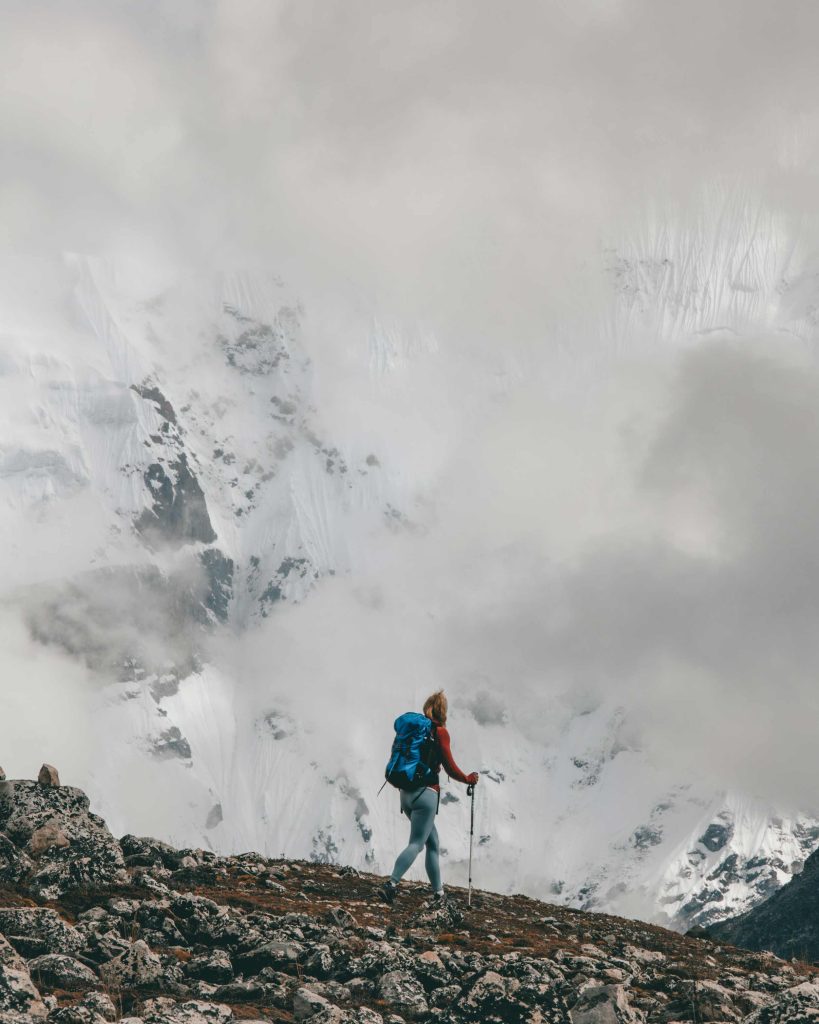
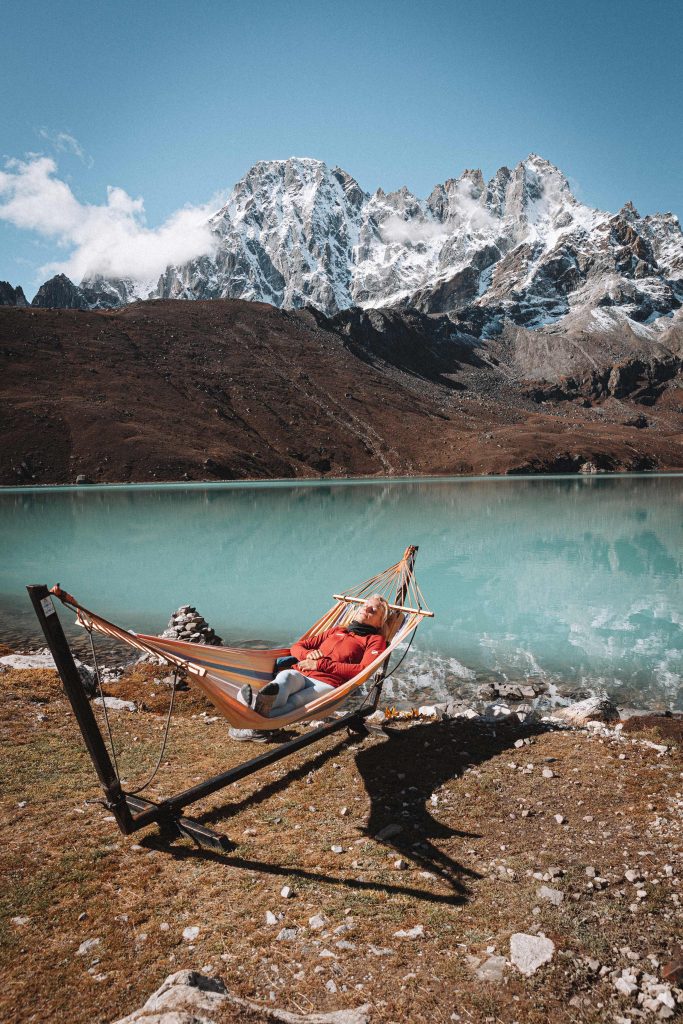

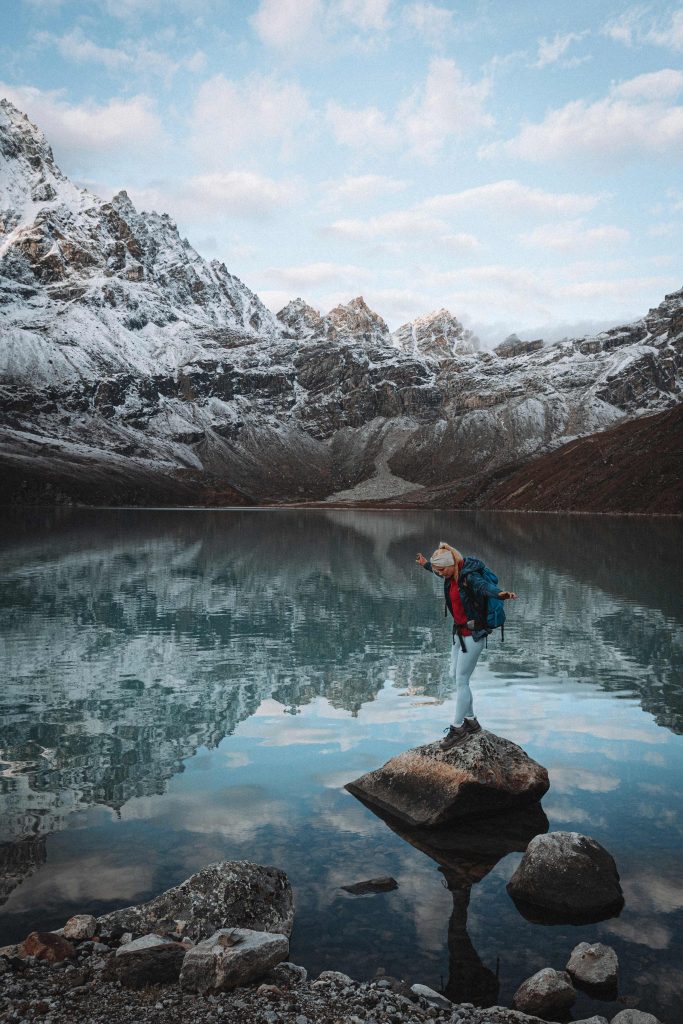


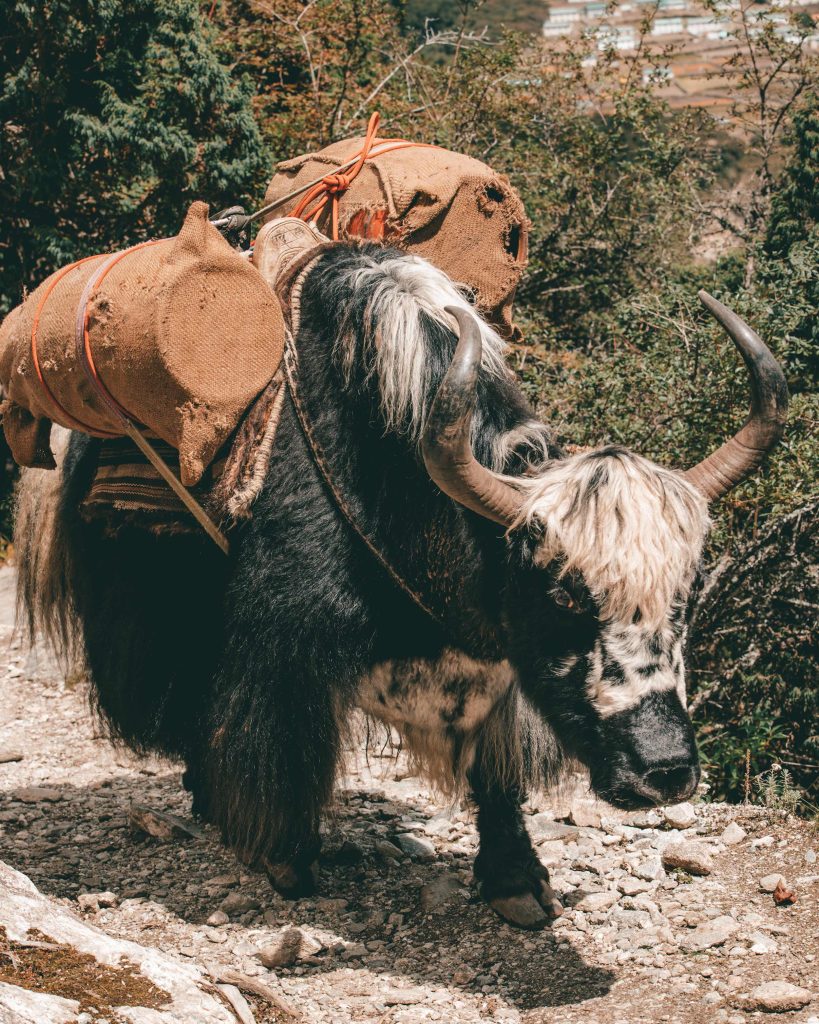
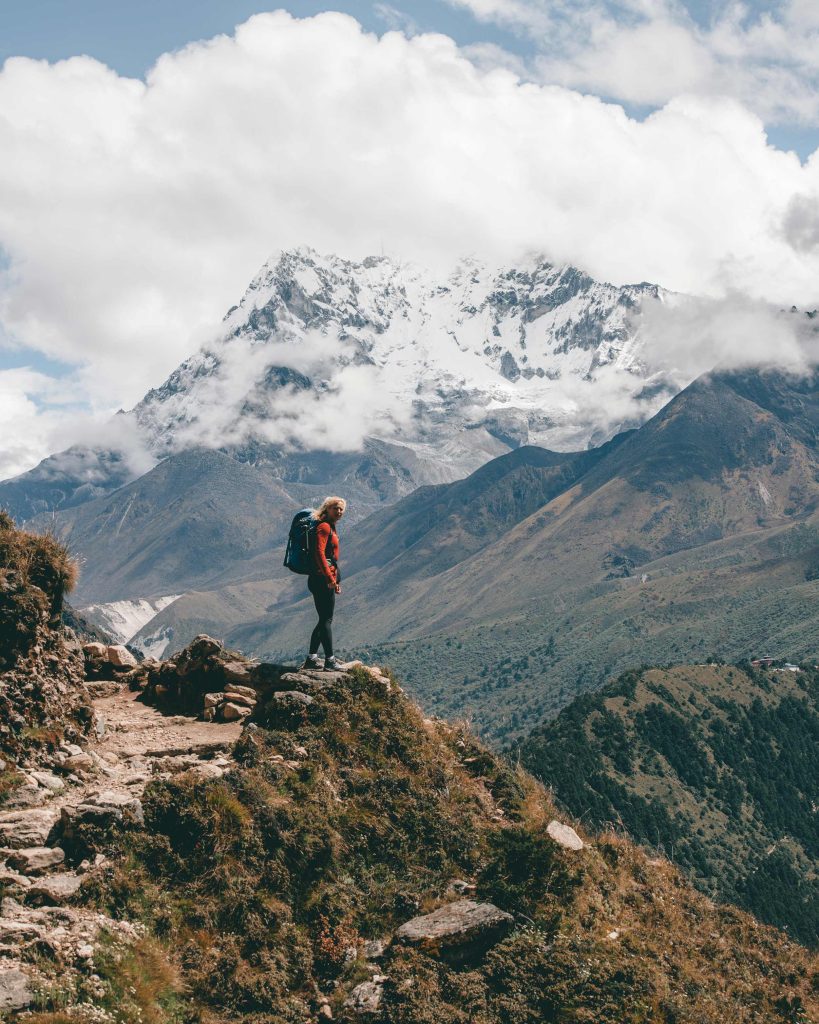

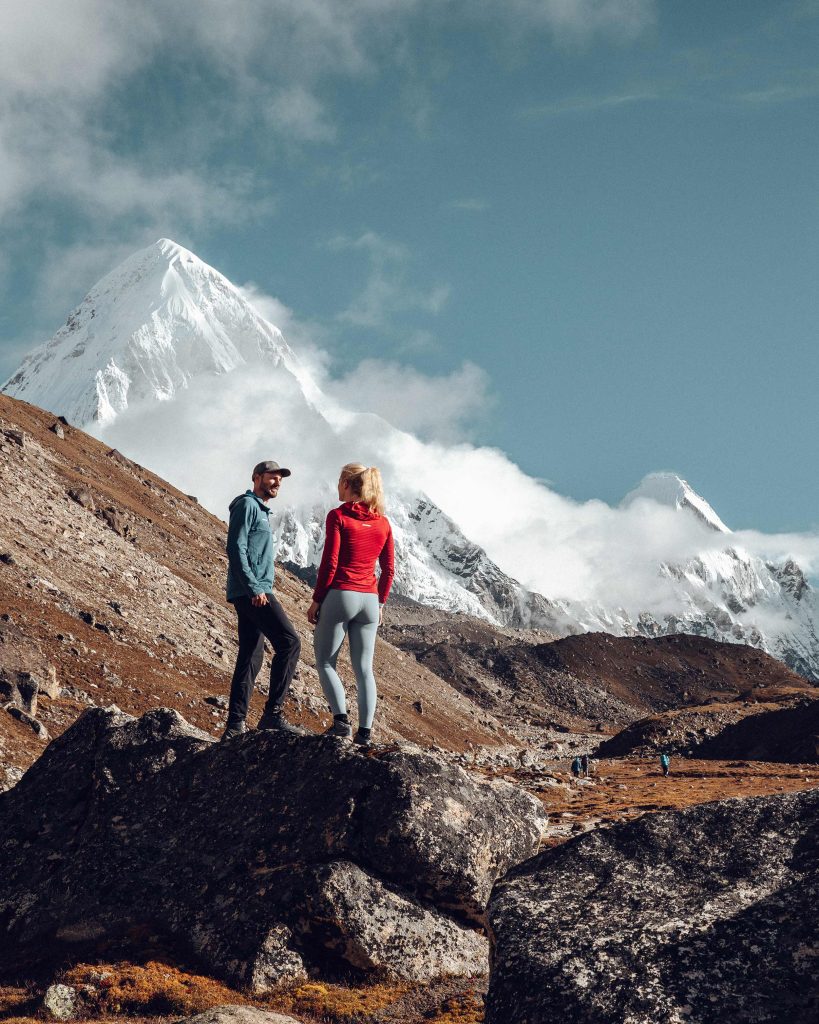

____________
Take a loop at the trek to climb a 6.000m peak ✓
Get some climbing equipment and training in Chukung ✓
____________
4. Climb the 6.189m Island Peak (Imja Tse), add 3 more days
There are a few Peaks in the Khumbu region that are above 6.000m and considered easy. One of these Peaks is the Imja Tse, also known as Island Peak. With 6.189m the peak is quite a bit higher than the peaks you might climb along the Three Passes Trek. The ascend includes crossing a glacier and slopes with up to 60 degree and depending on the season you will have to cross crevasses. This might sound intimidating, but you can climb this peak without being an experienced mountaineer. All you need is to be fit, acclimatized and to have a good guide.
How we did it:
We only learned about the Island Peak when we already started the Three Passes trek. Jana was immediately hooked by the idea to add Island Peak to our trek. After discussing our options for a few days, considering the required time and acclimatization, we decided to organize a guide and equipment passing Chukung, which is part of the Three Passes Trek and the starting point for Island Peak expeditions. We planned to then return there a few days later, after visiting Everest Base Camp.
But before we even reached Chukung, we met Karma Rita Sherpa, a wonderful guide, everest veteran and owner of a teahouse in Phortse. He offered to guide us on the mountain and organized equipment and permits for us. We still passed Chukung and visited EBC before meeting him again to climb Island Peak, just to make sure that we were sufficiently acclimatized.
The Expedition:
The starting Point for Island Peak is Chukung where you can also rent equipment. From there you will need two days to climb Island Peak and return. There are basecamps at around 5100m, which leaves you with around 1100m to reach the summit. There is a „high camp“ that will save you a few hundred meters for your ascend, but most climbers start from the lower camp.
Summit day usually starts around 1am and the first hours of the ascend are on rocky terrain, until you reach crampon point. There you adjust your gear and start crossing the glacier and finally climbing the steep slopes to the summit along fixed ropes. The ascend took us around 5 hours, the descend is a lot faster, so you can easily get back to Chukhung the same day.
How you can organize it in advance:
Just message Karma Rita Sherpa (messenger: Karma Rita Sherpa). He is a great guide and we can only recommend going with him. His son and his daughter are also experienced guides. Depending on the time of the season, you might be able to organize your expedition directly in Chukung, but we have heard that it gets crowded in high season.
↠ Read more: coming soon

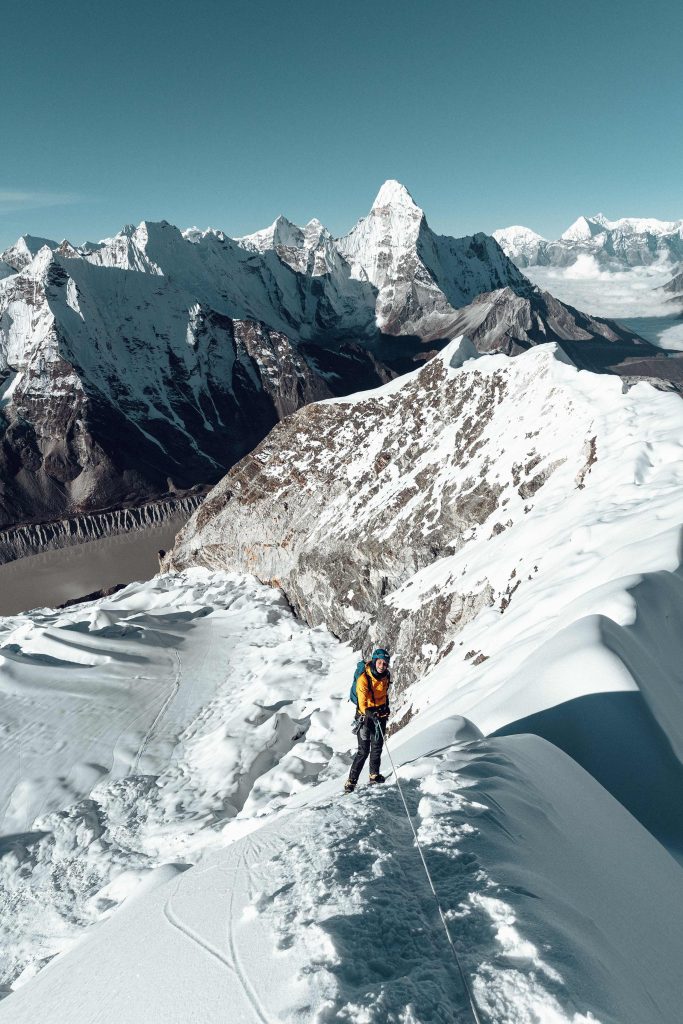







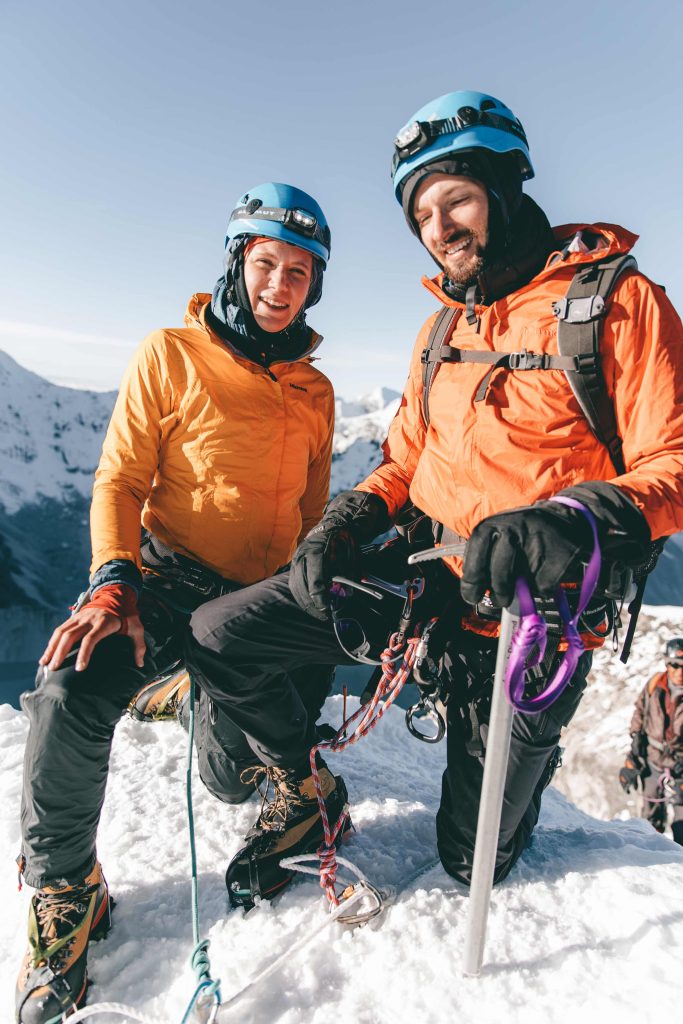

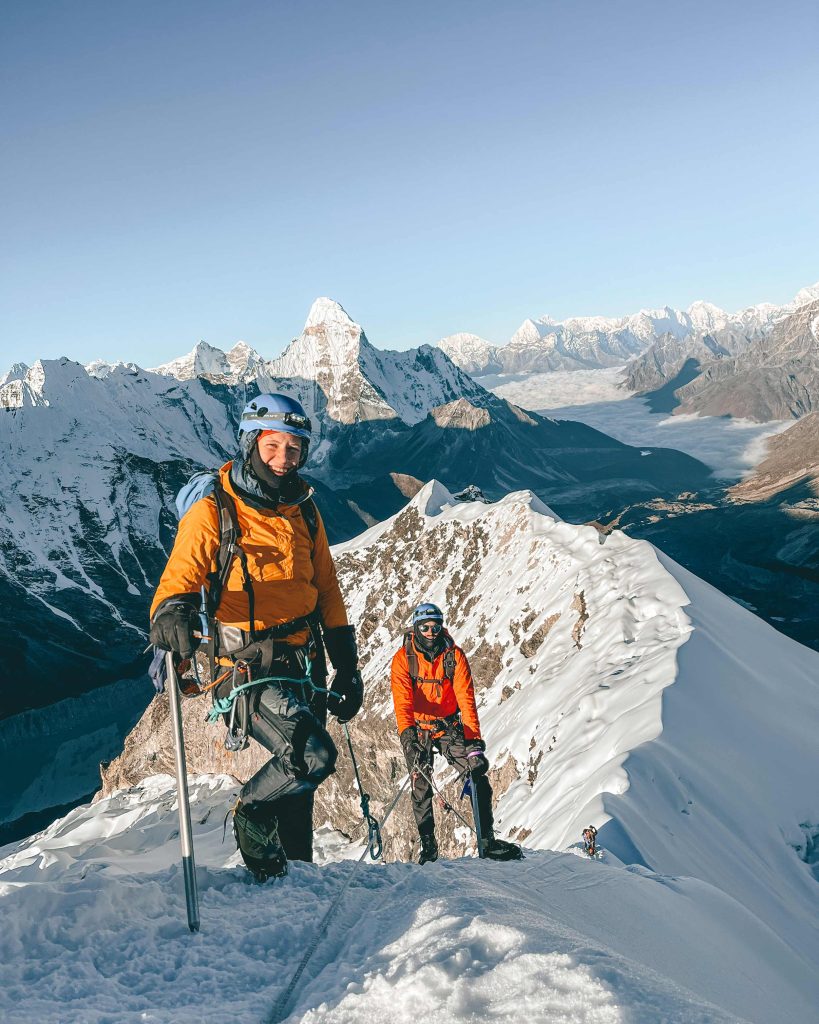
5. Fly in a helicopter
It wasn’t our original plan to fly out of the Himalayan mountains with a helicopter, although a lot of people recommend it. Even in the best season, weather can get bad, then propeller flights aren’t operating between Kathmandu and Lukla due to bad views between the small mountain gaps. It often happens that people get stuck in Lukla for a few days until they can get a return flight to Lukla. However, helicopters still operate on rainy and foggy days, so this is always an option two. On our way to Lukla we were able to get our propeller flight as we planned with 2 hour delay, although the days before all flights were cancelled. But on our last days of our hike, we heard that the weather will change and there might be around 3-5 days were all flights are cancelled. Therefore we decided to contact a few owners of the teahouses, who organized us a helicopter flight from Dhole back to Kathmandu for 500€. It was a dramatic but really beautiful flight, through the clouds and rain, although we couldn’t see a lot of mountains. A once-in-a-lifetime-experience. I remember how we observe the rain and fog outside, afraid that the helicopter can’t land and how fast we had to run when we heard the helicopter coming.


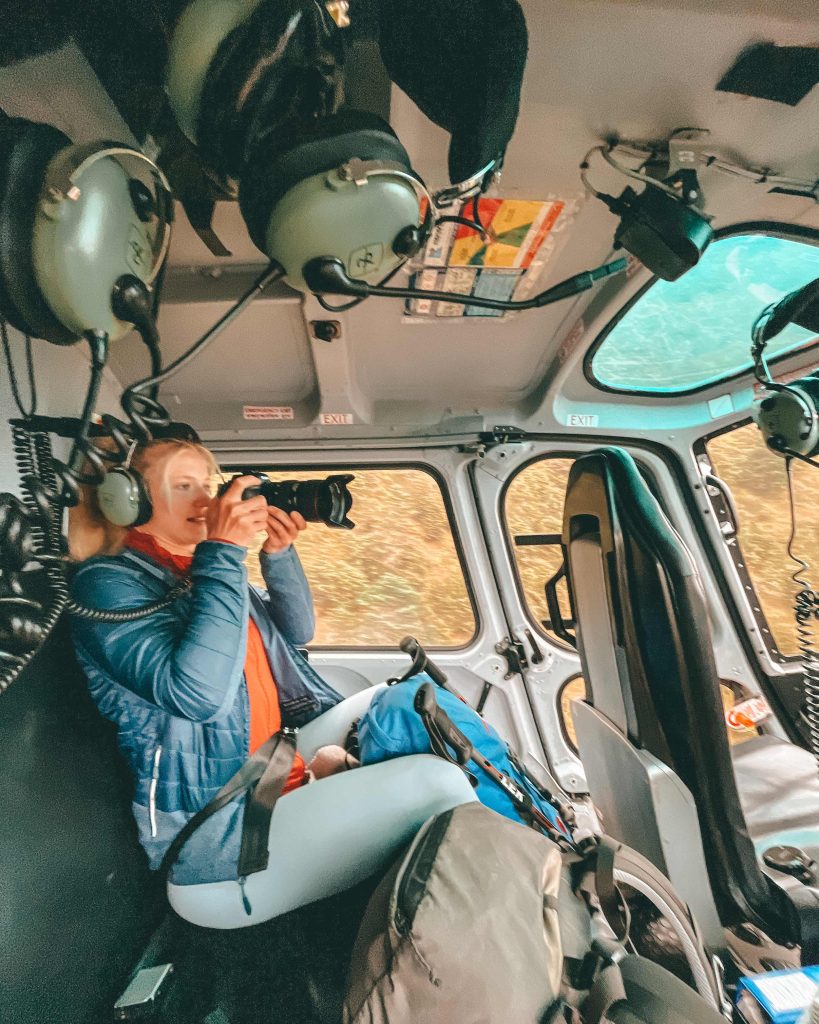

____________
Take a flight from Lukla back to Kathmandu ✓
OPTIONAL TO ADD : get a bus to Pokhara ✓
____________
6. Pokhara, add at least 3 more days
In contrast to the flight to Lukla, you can easily drive to Pokhara by car or bus in 6 to 7 hours. If you like, you can plan a stopover in Bandipur. There are several beautiful hikes in the Pokhara area, although they are located in less altitude, they all have a wonderful view on Annapurna Mountain. The most common trail is the Annapurna circuit, perfect for people who are a little afraid of altitudes over 5.000 meter. Pokhara itself is a cute little town located directly at a beautiful lake, with many nice cafés and buildings. When there is one thing to do in Nepal, it’s paragliding in Pokhara with a spectacular view on the Himalayan mountain range. You can also do a hike in the Mount Everest region and add a smaller 2 to 3 day hike in Pokhara.
What to do?
- explore Phewa Lake by boat
- Paraglyding
- Water Rafting
- Sarangkot Pokhara Viewpoint
- World Peace Pagoda
- Annapurna Circuit
- Poon Hill Trek
- Mohare Donda Trek (off the beaten trek)
Where to eat?
- The Juicery Café
- Roadhouse Café
- Linger Café & Restaurant
- am/pm organic café
- Café Concerto
- Potala Tibetan Restaurant
Where to stay?
- Waterfront Resort by KGH Group
- Aroma Tourist Hostel
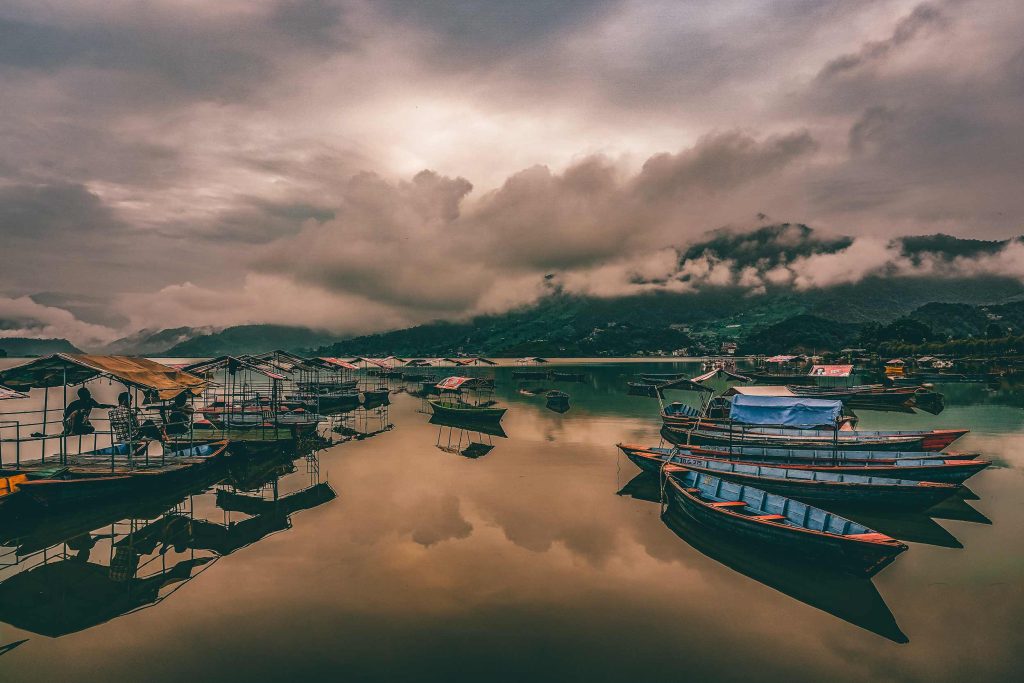

7. Bandipur, Lumbini and Chitwan National Park
The little town Bandipur is a little off the beaten trek, but absolutely worth it to visit, especially since you can use it as a stopover from Kathmandu to Pokhara. You can experience the Newari culture, motor vehicle free streets, cute restaurants and traditional buildings.
Lumbini is the birthplace of Buddha and a UNESCO World Heritage site. The Maya Devi temple is the exact side Buddha was born. But to be honest I would only recommend to come here, if you have time left and you have already seen everything else.
A lot of people add Chitwan National Park to their itinerary, however we wouldn’t recommend it. We heard that they provide elephant riding which doesn’t fit to our understanding of how to treat animals. Also there are other places in the world that are famous for their incredible animals in National Parks, for me Nepal is all about the mountains. However, you can find one-horned rhinos, Bengal tigers or leopards, elephants, sloth bears, crocodiles and monkeys in this National park. All trips start in Sauraha.

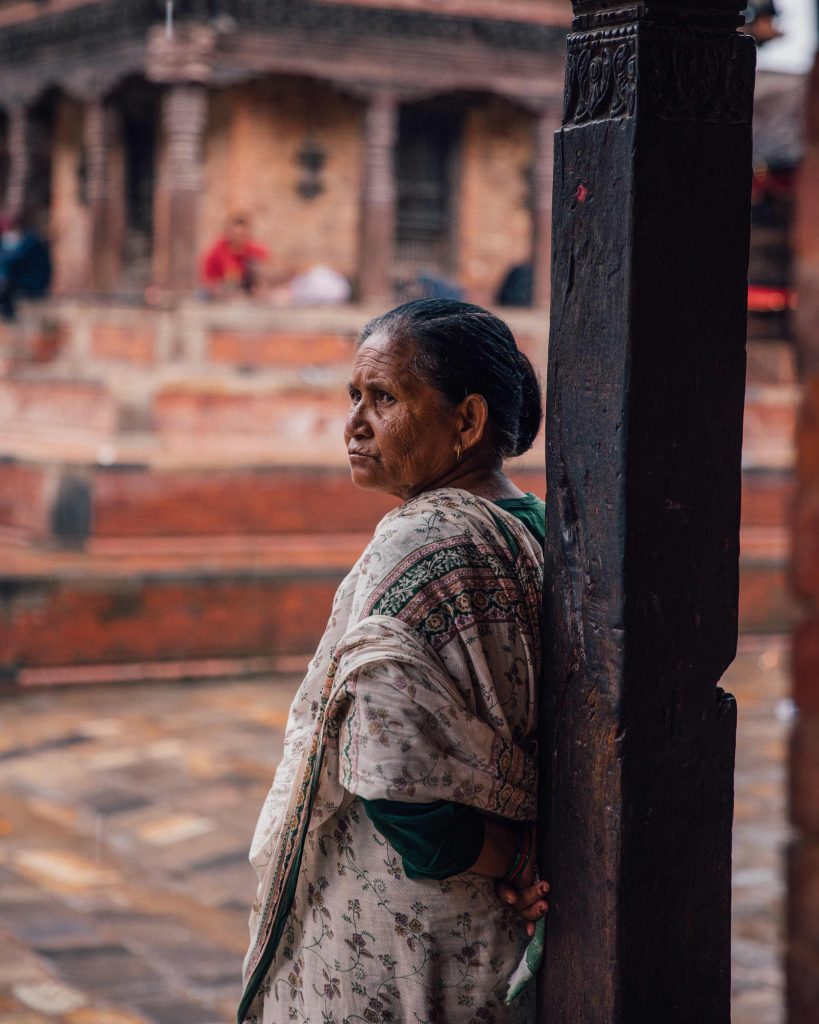
Best time to visit Nepal?
October to December: best time for trekking, clear sky and air, mostly no rain, colder temperatures
January to May: second best time, warmer temperatures, more dust around mountains
March: Holi festival
April: most Mount Everest ascents
June to September: wet season, not recommended since treks are often closed
We started our trek in the last week of September to avoid the crowds (most people start their trekking in October). We were very lucky with the weather. Most mornings we had a clear view on the mountains, around midday clouds started to cover the peaks. We had almost no rain. However, also in the best seasons it can rain for a few days.


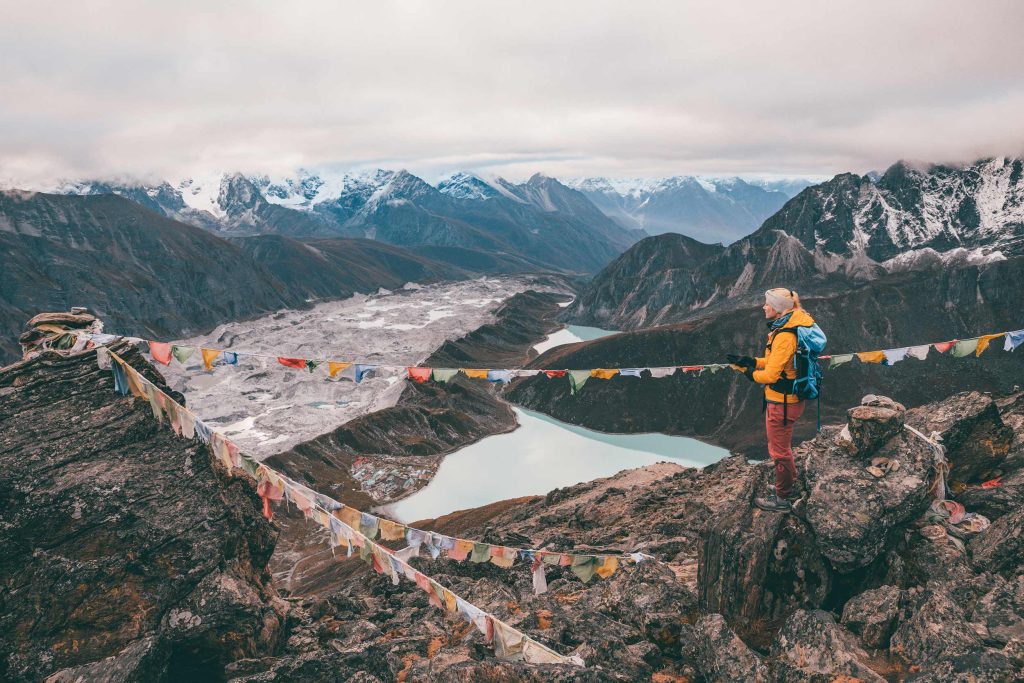
Which trek should I hike? Clockwise or anti clockwise?
We decided for the Three Passes Trek and added Everest Base Camp. Spontaneously we decided to add the climb of Island Peak (more than 6.000m) to our itinerary as well. We did the whole 3 Passes Trek and Everest Base Camp without any guide, just the two of us. It was absolutely doable! Only for a summit climb like Island Peak we got a mountain guide.
We went the trek anti clockwise, since it gives you a longer time to acclimatize. When going clockwise you will arrive at the first 5.000m very fast. But there are also a lot of people going clockwise, so it’s up to you.
Three Passes Trek
Route:
13 – 15 days. We did it without any guide.
Pro:
- Most beautiful mountain scenery all the time with snowy peaks
- 3 passes over 5.000m
- Not as crowded as EBC
- EBC can be added easily, add more days
- Very remote from civilization (but also bad if you deal with altitude sickness)
Contra:
- Most challenging and longest hike in high altitude
- Villages are used to tourists, some are less authentic
- You need gps and a map on your phone to find the hiking trails
- You need a 180€ flight to Lukla
Everest Base Camp Trek (EBC)
Route:
Around 12 days.
Pro:
- You will see the biggest mountain of the world Mount Everest
- Beautiful mountain scenery of the highest snowy mountains, and you are in the middle
- Sunrise view from Kala Patthar
- You can’t get lost, since the hikes have a good visibilityPperfect if you only have short time
- No cars or other motor vehicles
- You can add some side treks like Goyko lakes
- Tip: Namsche to Pangpoche via Phortse instead of Tengboche (less people)
Contra:
- It can get very crowded in high season (especially in October) with lots of donkeys carrying the luggage
- The villages are very used to tourists, less authentic
- You need a 180€ flight to Lukla
Annapurna Circuit
Route:
Around 15 days.
Pro:
- Authentic villages of locals
- Less crowded, most people hike between Manang and Jumpsee
- More culutre while trekking (1st part: buddhist territory, praying, temples, chanting, farming; 2nd part: Hindu culture and Mustang culture)
- Beautiful mountain scenery, Annapurna
- Cheaper guest houses
- Less altitude
- More independently people without guide on this trek
- High diversity of landscapes, forests, desert and peaks, but less snowy mountain parts
- You don’t need a flight, just go by bus to Pokhara
- You can add Poon Hill Trek and Tilicho Lakes
Contra:
- Vehicle traffic / bike traffic since there is a road next to hike most of the time, dusty sometimes
- A lot of trucks & construction
- No view on Mount Everest


What about the effects of the earthquake?
We didn’t noticed any specific effects of the earthquake, but we saw the horrible pictures in the documentaries. Some temples in Kathmandu were still under construction, but most buildings were rebuild. The infrastructure of the villages on the hike was very good.
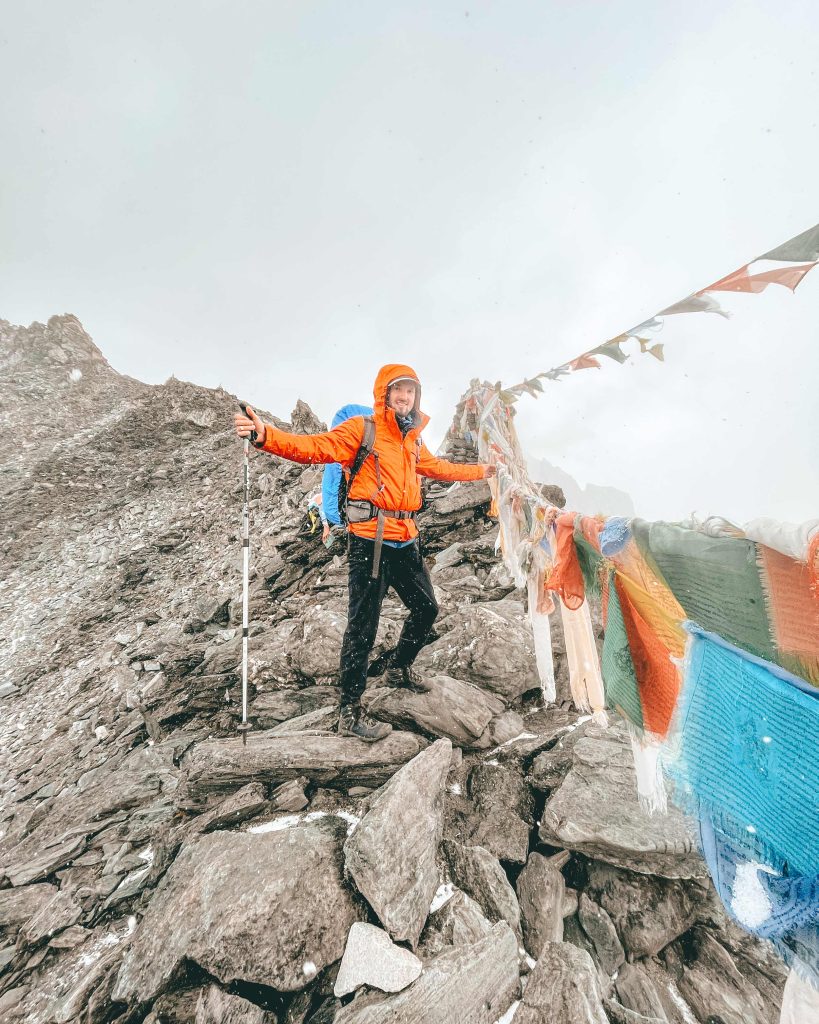
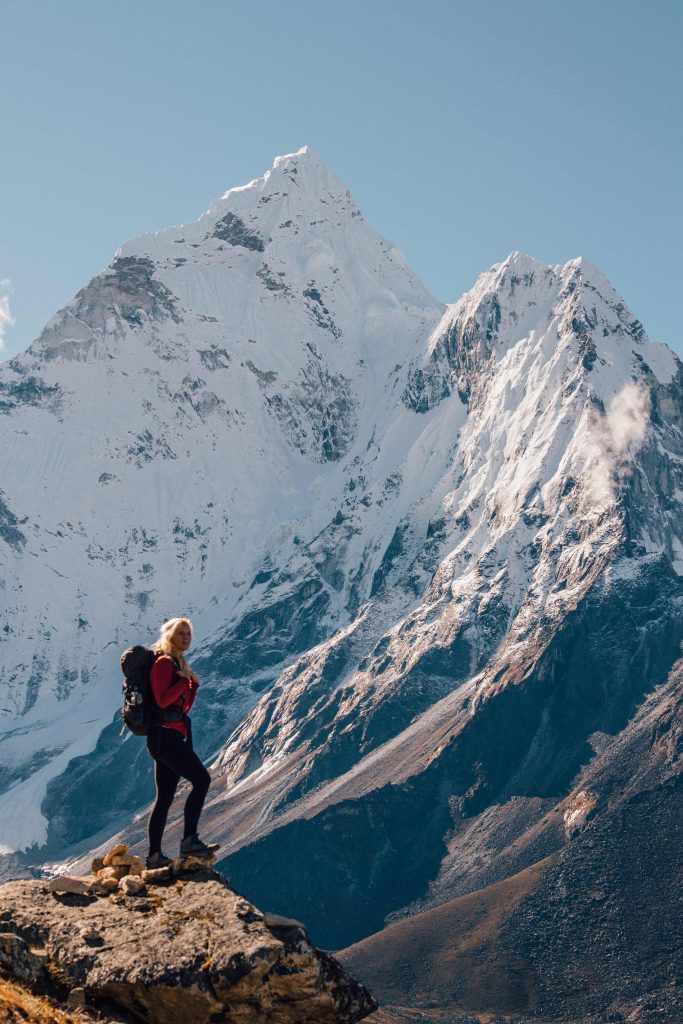
Did it feel save?
Nepal was one of the countries in the world we felt most save! We found the people extremely friendly, open and welcoming. Especially in the mountains everyone seemed to be in inner peace. We never heard anyone screaming or complaining. Even as a woman I would do this trip on my own without any doubts.

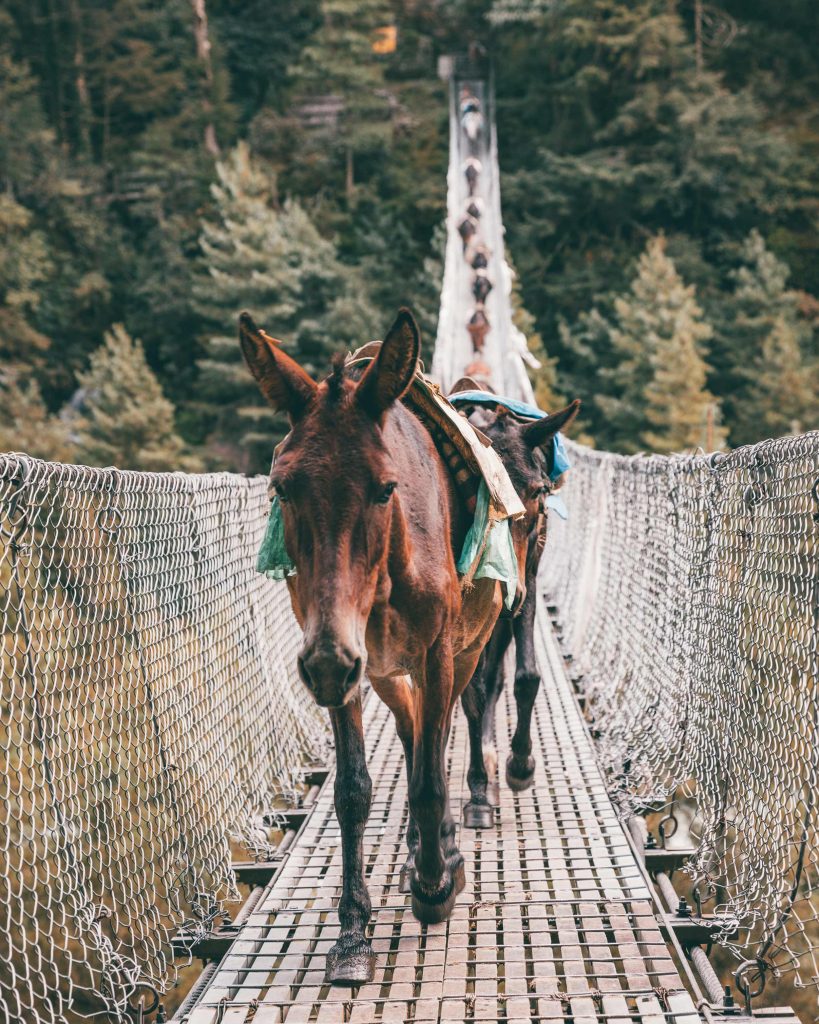
How expensive is Nepal?
Nepal’s currency is the Nepalese Rupee NPR. When we visited, 1 Euro was equal to 140 NPR. Overall Nepal is very cheap. You can get good homestay for 10€, most of the times the teahouses only cost a few euros, but the higher the altitude, the more expensive food gets since it has to be transported with helicopters. In Kathmandu and Pokhara you will find a lot of ATMs, however in the mountain regions it is best to take a great amount of cash with you, since teahouses often get payed in cash. There are some ATMs in bigger mountain villages like Dingboche, but sometimes they don’t have money. Some teahouses allow paying by credit card, but only if WIFI works.
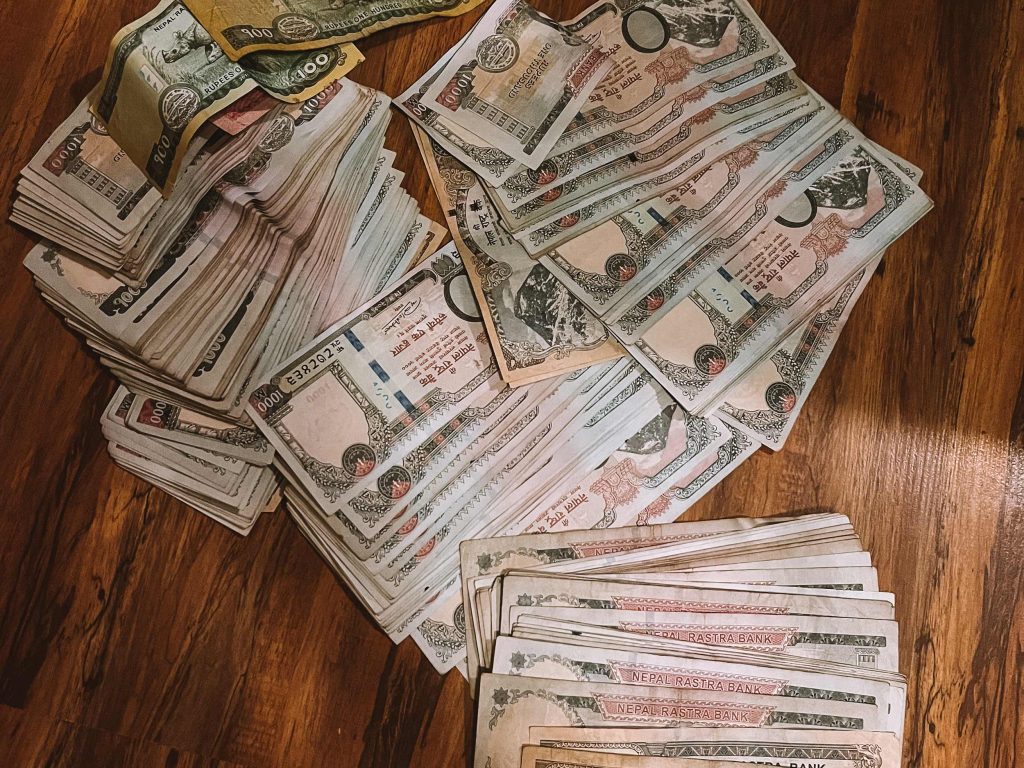
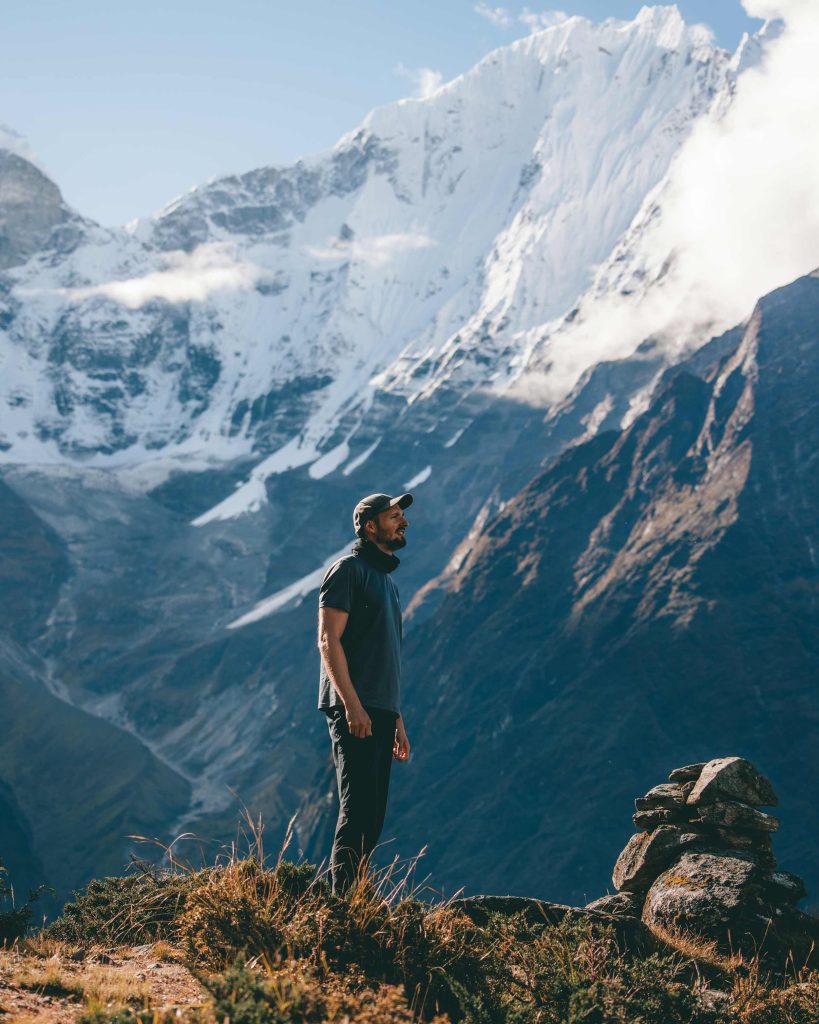
How to get around?
All international flights arrive in Kathmandu. Most people get a short inland propeller flight to Lukla, since the journey with a car on extremely bumpy mountain roads followed by a long hike in the end takes a lot of time. From Kathmandu to Pokhara most people take the bus or organize a driver. In Kathmandu it’s easiest to get an Uber or a tuktuk. In the mountains you have no other option than walking ;).



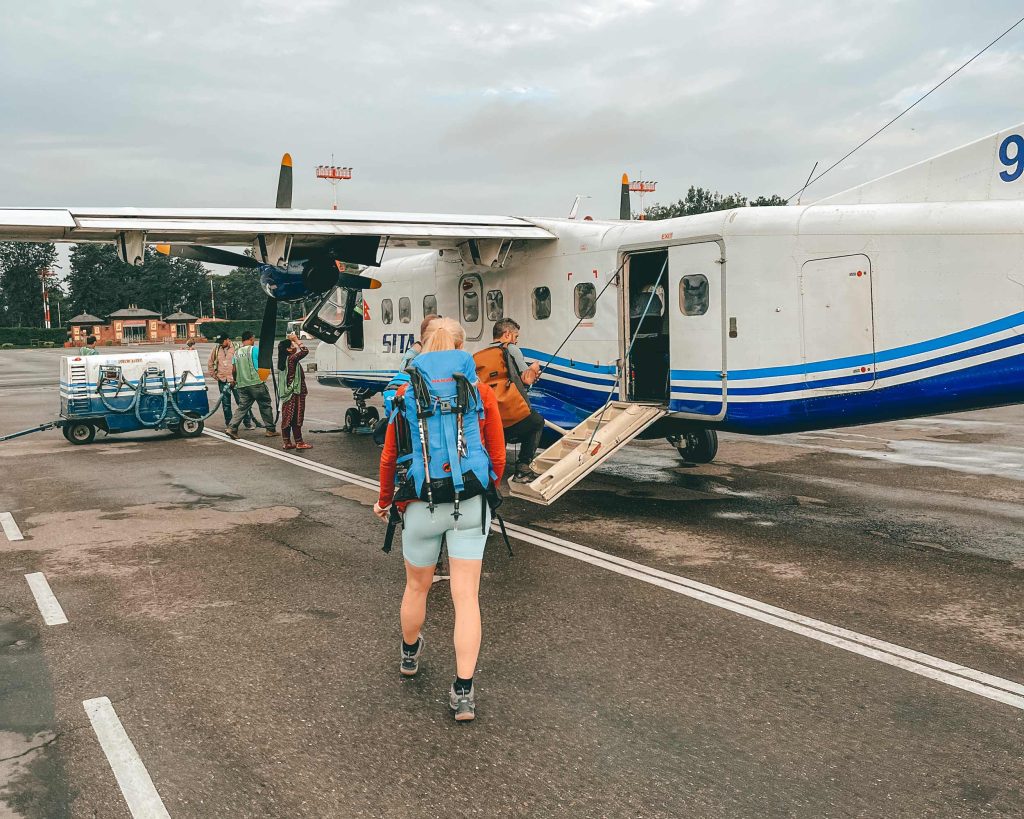
Where we would love to go next time in Nepal:
- hiking in the Mustang Region (North / middle)
- Canyon Swing east of Kathmandu
- Langtang Valley Trek, Yala Peak, Tsorgo Ri Peak, Kyanjin Ri Peak
- Manaslu Circuit Trek
- Climbing Ama Dablam
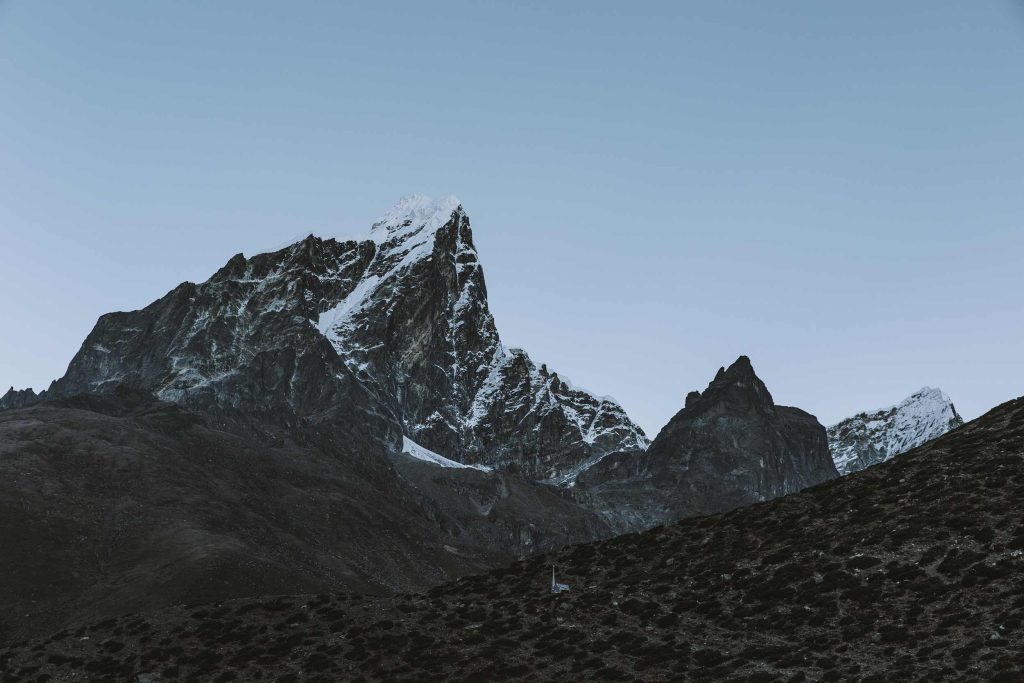
We visited Nepal in the end of September and October 2022.
Anzeige / ad: Most of the hotels, restaurants and companies we mentioned above didn’t sponsor us. All our recommendations are always based on our own opinion.
Follow our journey on Instagram